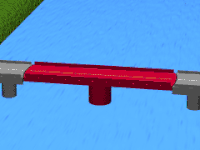Tour
A circular tour is a system by means of which two bodies are restricted in their freedom of movement:
In principle, bodies can move relative to one another in six degrees of freedom : they can be moved along three orthogonal axes (see " Cartesian coordinate system ") and they can be rotated around three axes.
A circular guide now restricts free movement to just one axis: a rotary movement of one body relative to another. (However , one can only speak of "one" body relative to " another " if there is only one body on the circumference on the outside, which takes on the function of guiding along the circular guide.)
A ball bearing is the best-known embodiment of a round guide: a wheel , for example a skater wheel or the front wheel of a bicycle , can only move in relation to its holder by using the one "released" axis for rotation . Another application of the circular guide can be found, for example, on the ramps on swing bridges; the respective contour of the ends then contains only one arc of a circumference and not a complete circumference. However, the ends of the ramps are not the only elements with a circular guide function; their tour function has a rather supportive character. Rather, the main round guidance function is taken over by the bearing at the upper end of the sole and centrally symmetrical pillar of the rotating part of the swing bridge.
The counterpart to a round guide is the linear guide .
The common generic term for round and linear guides is guidance (in the mechanical engineering or technical sense: restriction of freedom of movement). This term also has a counterpart: the fugue . A joint is a point of separation without any intentional movement of the parts towards one another.
